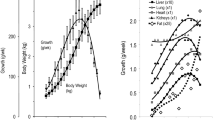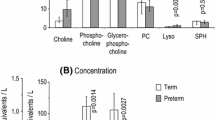Abstract
Background
Choline is essential to human development, particularly of the brain in the form of phosphatidylcholine, sphingomyelin and acetylcholine, for bile and lipoprotein formation, and as a methyl group donator. Choline is actively transported into the fetus, and maternal supply correlates with cognitive outcome. Interruption of placental supply may therefore impair choline homeostasis in preterm infants.
Objective
Determination of postnatal plasma concentrations of choline and its derivatives betaine and dimethylglycine (DMG) in preterm infants compared to cord and maternal blood matched for postmenstrual age (PMA).
Design
We collected plasma of very low-birth-weight infants undergoing neonatal intensive care (n = 162), cord plasma of term and preterm infants (n = 176, 24–42-week PMA), serum of parturients (n = 36), and plasma of healthy premenopausal women (n = 40). Target metabolites were analyzed with tandem mass spectrometry and reported as median (25th/75th percentiles).
Results
Cord plasma choline concentration was 41.4 (31.8–51.2) µmol/L and inversely correlated with PMA. In term but not in preterm infants, cord plasma choline was lower in girls than in boys. Prenatal glucocorticoid treatment did not affect choline levels in cord plasma, whereas betaine was decreased and DMG increased. In parturients and non-pregnant women, choline concentrations were 14.1 (10.3–16.9) and 8.8 (5.7–11.2) µmol/L, respectively, whereas betaine was lowest in parturients. After delivery, preterm infant plasma choline decreased to 20.8 (16.0–27.6) µmol/L within 48 h. Betaine and DMG correlated with plasma choline in all groups.
Conclusions
In preterm infants, plasma choline decreases to 50 % of cord plasma concentrations, reflecting choline undernourishment and postnatal metabolic adaptation, and potentially contributing to impaired outcome.



Similar content being viewed by others
Abbreviations
- AI:
-
Adequate intake
- BHMT:
-
Betaine homocysteine methyltransferase
- D:
-
Deuterium
- DHA:
-
Docosahexaenoic acid
- DMG:
-
Dimethylglycine
- EDTA:
-
Ethylene diamine tetraacetate
- H-ESI:
-
Heated electrospray ionization interface
- HPLC:
-
High performance liquid chromatography
- LC–ESI–MS/MS:
-
Liquid chromatography–electrospray ionization interface tandem mass spectrometry
- LC–PUFA:
-
Long-chain poly-unsaturated fatty acid
- NICU:
-
Neonatal intensive care unit
- PC:
-
Phosphatidylcholine
- PE:
-
Phosphatidylethanolamine
- PEMT:
-
PE-N-methyltransferase
- PMA:
-
Postmenstrual age
- SAM:
-
S-adenosylmethionine
- SM:
-
Sphingomyelin
- SRM:
-
Specific reaction monitoring
- TIC:
-
Total ion count
- VLDL:
-
Very low-density lipoproteins
- w:
-
Week
References
Institute of Medicine, National Academy of Sciences USA (1998) Dietary reference intakes for folate, thiamin, riboflavin, niacin, vitamin B12, papntothenic acid, biotin, and choline, vol 1. National Academy Press, Washington, DC
Greenberger NJ, Isselbacher KJ (1998) Diseases of the gallbladder and bile ducts. In: Fauci A, Braunwald E, Isselbacher KJ, Wilson JD, Martin JB (eds) Harrison’s principles of internal medicine. McGraw-Hill, New York, pp 1725–1726
Zeisel SH (2006) Choline: critical role during fetal development and dietary requirements in adults. Annu Rev Nutr 26:229–250
Oshida K, Shimizu T, Takase M, Tamura Y, Shimizu T, Yamashiro Y (2003) Effects of dietary sphingomyelin on central nervous system myelination in developing rats. Pediatr Res 53:589–593
Zeisel SH, Blusztajn JK (1994) Choline and human nutrition. Annu Rev Nutr 4:269–296
Lauder JM, Schambra UB (1999) Morphogenetic roles of acetylcholine. Environ Health Perspect 107(Suppl 1):65–69
Yan J, Jiang X, West AA, Perry CA, Malysheva OV, Devapatla S, Pressman E, Vermeylen F, Stabler SP, Allen RH, Caudill MA (2012) Maternal choline intake modulates maternal and fetal biomarkers of choline metabolism in humans. Am J Clin Nutr 95:1060–1071
Pynn CJ, Henderson NG, Clark H, Koster G, Bernhard W, Postle AD (2011) Specificity and rate of human and mouse liver and plasma phosphatidylcholine synthesis analyzed in vivo. J Lipid Res 52:399–407
Stöckler S, Isbrandt D, Hanefeld F, Schmidt B, von Figura K (1996) Guanidinoacetate methyltransferase deficiency: the first inborn error of creatine metabolism in man. Am J Hum Genet 58:914–922
Bernhard W, Full A, Arand J, Maas C, Poets CF, Franz AR (2013) Choline supply of preterm infants: assessment of dietary intake and pathophysiological considerations. Eur J Nutr 52:1269–1278
Fischer LM, da Costa KA, Galanko J, Sha W, Stephenson B, Vick J, Zeisel SH (2010) Choline intake and genetic polymorphisms influence choline metabolite concentrations in human breast milk and plasma. Am J Clin Nutr 92:336–346
Zeisel SH (2006) The fetal origins of memory: the role of dietary choline in optimal brain development. J Pediatr 149:S131–S136
Jiang X, Yan J, West AA, Perry CA, Malysheva OV, Devapatla S, Pressman E, Vermeylen F, Caudill MA (2012) Maternal choline intake alters the epigenetic state of fetal cortisol regulating genes in humans. FASEB J 26:3563–3574
Wu BT, Dyer RA, King DJ, Richardson KJ, Innis SM (2012) Early second trimester maternal plasma choline and betaine are related to measures of early cognitive development in term infants. PLoS One 7(8):e43448. doi:10.1371/journal.pone.0043448
Strain JJ, McSorley EM, van Wijngaarden E, Kobrosly RW, Bonham MP, Mulhern MS, McAfee AJ, Davidson PW, Shamlaye CF, Henderson J, Watson GE, Thurston SW, Wallace JM, Ueland PM, Myers GJ (2013) Choline status and neurodevelopmental outcomes at 5 years of age in the Seychelles Child Development Nutrition Study. Br J Nutr 9:1–7
Molloy AM, Mills JL, Cox C, Daly SF, Conley M, Brody LC, Kirke PN, Scott JM, Ueland PM (2005) Choline and homocysteine interrelations in umbilical cord and maternal plasma at delivery. Am J Clin Nutr 82:836–842
Ozarda Ilcol Y, Uncu G, Ulus IH (2002) Free and phospholipid-bound choline concentrations in serum during pregnancy, after delivery and in newborns. Arch Physiol Biochem 110:393–399
Hogeveen M, den Heijer M, Semmekrot BA, Sporken JM, Ueland PM, Blom HJ (2013) Umbilical choline and related methylamines betaine and dimethylglycine in relation to birth weight. Pediatr Res 73:783–787
Chao CK, Pomfret EA, Zeisel SH (1988) Uptake of choline by rat mammary-gland epithelial cells. Biochem J 254:33–38
Holmes-McNary MQ, Cheng WL, Mar MH, Fussell S, Zeisel SH (1996) Choline and choline esters in human and rat milk and in infant formulas. Am J Clin Nutr 64:572–576
Caudill MA (2010) Pre- and post-natal health: evidence of increased choline needs. J Am Diet Assoc 110:1198–1206
Yan J, Jiang X, West AA, Perry CA, Malysheva OV, Brenna JT, Stabler SP, Allen RH, Gregory JF III, Caudill MA (2013) Pregnancy alters choline dynamics: results of a randomized trial employing stable isotope methodology in pregnant and nonpregnant women. Am J Clin Nutr 98(1):9
Stocker JT, Dehner LP, Husain AN (2001) Means and standard deviations of weights and measurements of lifeborn infants by body weight. In: Stocker JT, Dehner LP (eds) Stocker & Dehner’s pediatric pathology, Appendix 28-29, 2nd edn. Philadelphia, PA, pp 1302–1304
Wikland KA, Luo ZC, Niklasson A, Karlberg J (2001) Swedish population-based longitudinal reference values from birth to 18 years of age for height, weight and head circumference. Acta Paediatr 91:739–754
Voigt M, Rochow N, Straube S, Briese V, Olbertz D, Jorch G (2010) Birth weight percentile charts based on daily measurements for very preterm male and female infants at the age of 154–223 days. J Perinat Med 38:289–295
Rochow N, Fusch G, Choi A, Chessell L, Elliott L, McDonald K, Kuiper E, Purcha M, Turner S, Chan E, Xia MY, Fusch C (2013) Target fortification of breast milk with fat, protein, and carbohydrates for preterm infants. J Pediatr 163:1001–1007
McMahon KE, Farrell PM (1985) Measurement of free choline concentrations in maternal and neonatal blood by micropyrolysis gas chromatography. Clin Chim Acta 149:1–12
Decsi T, Fekete M, Szász M, Burus I (1993) Lipid and apolipoprotein levels and enteral nutrition in very low-birth-weight preterm infants. Acta Paediatr 82:663–665
Lever M, Slow S (2010) The clinical significance of betaine, an osmolyte with a key role in methyl group metabolism. Clin Biochem 43:732–744
Graber CD, Goust JM, Glassman AD, Kendall R, Loadholt CB (1981) Immunomodulating properties of dimethylglycine in humans. J Infect Dis 143:101–105
Bligh EG, Dyer WJ (1959) A rapid method of total lipid extraction and purification. Can J Biochem Physiol 37:911–917
Bernhard W, Pynn CJ, Jaworski A, Rau GA, Hohlfeld JM, Freihorst J, Poets CF, Stoll D, Postle AD (2004) Mass spectrometric analysis of surfactant metabolism in human volunteers using deuteriated choline. Am J Respir Crit Care Med 170:54–58
Sun T, Wetzel SJ, Johnson ME, Surlow BA, Patton-Vogt J (2012) Development and validation of a hydrophilic interaction liquid chromatography-tandem mass spectrometry method for the quantification of lipid-related extracellular metabolites in Saccharomyces cerevisiae. J Chromatogr B Anal Technol Biomed Life Sci 897:1–9
Zeisel SH, Mar MH, Zhou Z, da Costa KA (1995) Pregnancy and lactation are associated with diminished concentrations of choline and its metabolites in rat liver. J Nutr 125:3049–3054
Lockman PR, Allen DD (2002) The transport of choline. Drug Dev Ind Pharm 28:749–771
Wurtman RJ (1992) Choline metabolism as a basis for the selective vulnerability of cholinergic neurons. Trends Neurosci 15:117–122
Klein J, Köppen A, Löffelholz K (1990) Small rises in plasma choline reverse the negative arteriovenous difference of brain choline. J Neurochem 55:1231–1236
Larqué E, Demmelmair H, Berger B, Hasbargen U, Koletzko B (2003) In vivo investigation of the placental transfer of (13)C-labeled fatty acids in humans. J Lipid Res 44:49–55
Bernhard W, Raith M, Koch V, Kunze R, Maas C, Abele H, Poets CF, Franz AR (2014) Plasma phospholipids indicate impaired fatty acid homeostasis in preterm infants. Eur J Nutr. [Epub ahead of print]. doi:10.1007/s00394-014-0658-3
Noga AA, Zhao Y, Vance DE (2002) An unexpected requirement for phosphatidylethanolamine N-methyltransferase in the secretion of very low density lipoproteins. J Biol Chem 277:42358–42365
Fischer LM, da Costa KA, Kwock L, Galanko J, Zeisel SH (2010) Dietary choline requirements of women: effects of estrogen and genetic variation. Am J Clin Nutr 92:1113–1119
Resseguie ME, da Costa KA, Galanko JA, Patel M, Davis IJ, Zeisel SH (2011) Aberrant estrogen regulation of PEMT results in choline deficiency-associated liver dysfunction. J Biol Chem 286:1649–1658
Imbard A, Smulders YM, Barto R, Smith DE, Kok RM, Jakobs C, Blom HJ (2013) Plasma choline and betaine correlate with serum folate, plasma S-adenosyl-methionine and S-adenosyl-homocysteine in healthy volunteers. Clin Chem Lab Med 51:683–692
Banerjee RV, Matthews RG (1990) Cobalamin-dependent methionine synthase. FASEB J 4:1450–1459
Friesen RW, Novak EM, Hasman D, Innis SM (2007) Relationship of dimethylglycine, choline, and betaine with oxoproline in plasma of pregnant women and their newborn infants. J Nutr 137:2641–2646
Gwee MC, Sim MK (1979) Changes in the concentration of free choline and cephalin-N-methyltransferase activity of the rat material and foetal liver and placenta during gestation and of the maternal and neonatal liver in the early postpartum period. Clin Exp Pharmacol Physiol 6:259–265
Zeisel SH (2012) Diet-gene interactions underlie metabolic individuality and influence brain development: implications for clinical practice derived from studies on choline metabolism. Ann Nutr Metab 60(Suppl 3):19–25. doi:10.1159/000337310
Fridman O, Morales AV, Bortoni LE, Turk-Noceto PC, Prieto EA (2012) Corticoadrenal activity in rat regulates betaine-homocysteine S-methyltransferase expression with opposite effects in liver and kidney. J Biosci 37:115–123
Yue B, Pattison E, Roberts WL, Rockwood AL, Danne O, Lueders C, Möckel M (2008) Choline in whole blood and plasma: sample preparation and stability. Clin Chem 54:590–593
Acknowledgements
This study was supported by an institutional grant (Project No. E.1100008) of the ZEM—Zentrum Ernährungsmedizin of the Medical Faculty of the University of Tuebingen and the University of Hohenheim. The authors have no financial relationships relevant to this article to disclose. This study was funded by an internal grant of the Eberhard-Karls-University, Tübingen, and the University of Hohenheim, Stuttgart, Germany (ZEM 4A II-08).
Conflict of interest
The authors have no conflict of interests to disclose.
Author information
Authors and Affiliations
Corresponding author
Additional information
Study registration: This study was registered at www.clinicaltrials.gov. Identifier: NCT02027584.
Electronic supplementary material
Below is the link to the electronic supplementary material.
Rights and permissions
About this article
Cite this article
Bernhard, W., Raith, M., Kunze, R. et al. Choline concentrations are lower in postnatal plasma of preterm infants than in cord plasma. Eur J Nutr 54, 733–741 (2015). https://doi.org/10.1007/s00394-014-0751-7
Received:
Accepted:
Published:
Issue Date:
DOI: https://doi.org/10.1007/s00394-014-0751-7




